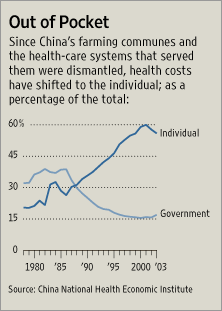The Washington Post covers AOL founder Steve Case’s new venture, Revolution Health. They describe it as “A Big Ticket Start-Up With a Nonprofit Vibe,” which seems to be a polite way of saying that the group is disorganized and having trouble pulling itself together. But they have big dreams:
Ambitious banter (“building a company that can change the world,” Case says) injects the place with a nonprofit vibe, which attracted the likes of Brad Jacobs, a physician and former researcher at the University of California at San Francisco who is Revolution Health’s senior medical director.
“I can be much more true to consumers’ needs here than in an academic hospital setting,” Jacobs said.
The problem is that they’re not dreaming big, at least judging by what’s on the screen. It’s WebMD redux, presented in a visually unexciting way. It’s not something you want to touch, feel, and interact with.
I want this venture to be dynamic and exciting, and to bring new energy to the world of online health. So far, that isn’t happening. When it comes to health, that most intimate of functions, you want a virtual space that radiates something unique, not something with the aesthetic vibe of a claim form.
I had my objections to AOL during the mid-90’s, as did a lot of techies and “early adapters.” It seemed to be more of a “cage” than a “portal,” designed to limit rather than foster free and open access to the Internet. (Eventually customer demand forced them to change.)
That said, Case and company were brilliantly successful in creating a warm, navigable, and comfortable “user space” for AOL. I had hoped Revolution Health would do the same for health care, but so far it’s flat and uninteresting. It doesn’t invite users in by hooking them based on points of interest, excitement, or need.
There are many visually and conceptually exciting things that can be done with this concept. I hope they act in a bolder way, and soon, to bring in some new design ideas.
There may also be a conceptual flaw in the way Case et al. are going about it. There seems to be a strong bias toward the “consumer-driven health” model, where people buy health services the way they do other “products.” Here’s the problem: The health industry’s been pushing consumer-driven health for years and “consumers” haven’t been interested.
I could go on at length about why I think that is: sociology, economics, etc. But suffice it to say that healthcare’s an economy where the supplier – the physician – also controls demand. it’s hard weaning people away from that. (Just ask my Joe Paduda and the others among us who have been having this debate for years.)
That said, studies also show that people will make better decisions given the right information – but getting the “right information,” and “information that’s right,” is key. And there are ways to array and present that information that make it much more navigable, friendly, and useful.
A key aspect of the site is the ability to select physicians based on what other Revolution Health users have to say about them. Problem #1: Months after their creation, I wasn’t able to find a single allergist within five miles of me who had a single user rating (and I live in Los Angeles.) That can be fixed, but it takes time and a critical mass of subscribers.
Problem #2: I wouldn’t choose a physician solely based on what a self-selected group of untrained people say about them. I’m not sure many people would. There are better ways to profile physicians, and Revolution Health should tap into them.
Case is a creative guy, and he has the able to keep attracting talented people to this venture. It’s still early enough for them to step back and re-design their product from the ground up, tapping into the deepest wellsprings of creativity they can find.
I think that would be a terrific idea.

